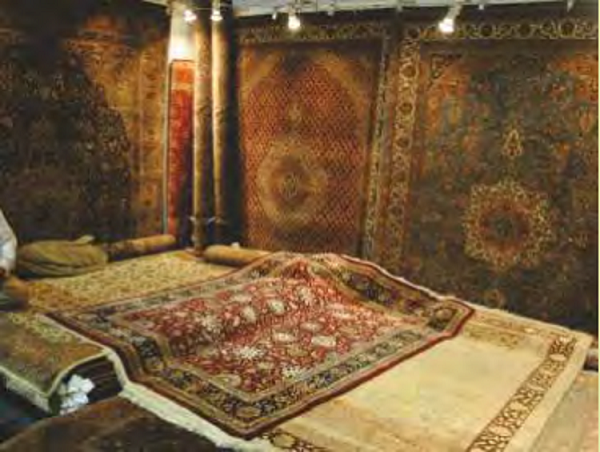Kashmir Carpets / Kashmir Rugs

The woolen and silken carpets of Jammu and Kashmir remain unparalleled on the national scene and have enjoyed unprecedented fame. Kashmir carpets are handmade, hand-knotted, and made of pure wool and silk.
The Kashmiri craftsman mainly from rural Kashmir possessing a unique talent for intricate workmanship is one of our most important resources “the greatest weaving magicians in the world’ came from Kashmir”.
The Oldest Kashmir Carpets Were Of Floral Design With Mosques, Gardens, Wild Animals, Gliding Fishes Etc. They are made in sizes like 3’x2′, 4’x2’6″, 5’x3′, 6’x4′, 7’x5′, 10’x8′, 12’x9′ and 14’x10′ large size are only made on order basis.
These carpets are renowned for having bright, jewel-like color tones such as sapphire blue, ruby red, emerald green, aquamarine, amethyst, and ivory. They are rooted in the Kashmiri way of living and no home in Kashmir is complete without a carpet.
Carpet Industry in India
This industry in India took birth as a result of the Mughal Dynasty who had imported Persian and Turkish weavers in the country for the production of carpets for their palaces. On the downfall of this dynasty, the industry was shaken. However, they picked up as independent units during the post-British period, and now the industry is growing with its utmost glory from the states of Rajasthan, Kashmir, Punjab, Uttar Pradesh, Andhra Pradesh, and Himachal Pradesh.
Indian carpets are famous and known worldwide for their magnificent designs and heart-winning workmanship. Hand-knotted woolen carpets, tufted woolen carpets, chain-stitch rugs, pure silk carpets, staple/synthetic carpets, handmade woolen Durries are some of the types for which there is a huge market demand in the European and American markets.
Carpet weaving
Carpet involves the most intricate forms of weaving. Weaving almost one million knots per square meter a craftsman turns a silk carpet into a marvelous piece of art. Famous throughout the world, carpet weaving in Kashmir has been passed and perfected through generations. Carpets are woven on wooden looms across rural and urban Kashmir. A carpet is completed in several months or years depending on the density and size. Raw materials used are wool, silk, and mercerized cotton.
Unlike the Chinese machine-made carpets or the conventional Persian carpets from Iran, Indian handmade carpets present a mix of traditional and contemporary designs and speak of high workmanship.
How to recognize fake and real Kashmir carpet
Kashmir carpets come in a range of colors, designs, and sizes, so it may be difficult to tell by just looking at the Kashmir carpet design, but in any case, a real Kashmir carpet should be completely handmade. The most important aspect of determining the quality and the value of a Kashmir carpet is the quality of the carpet fiber and also its knitting. A quality Kashmir carpet should be handmade or hand-knotted from pure wool or pure silk. A lower-quality Kashmir carpet may be made out of a blend of wool, rayon, and silk.
Suggested Read: Jammu Kashmir – Culture and Tradition






